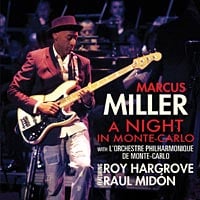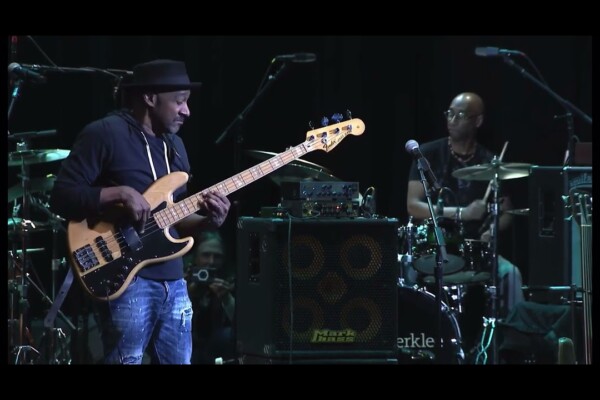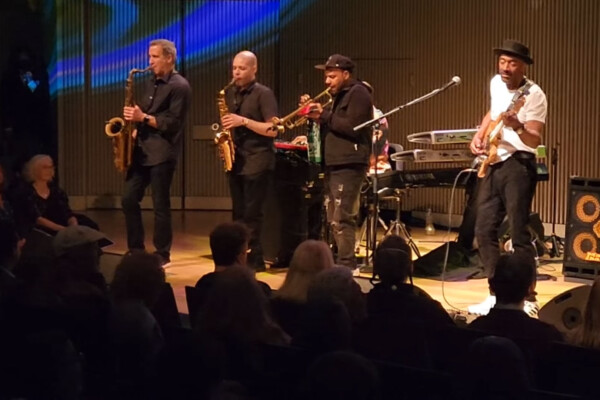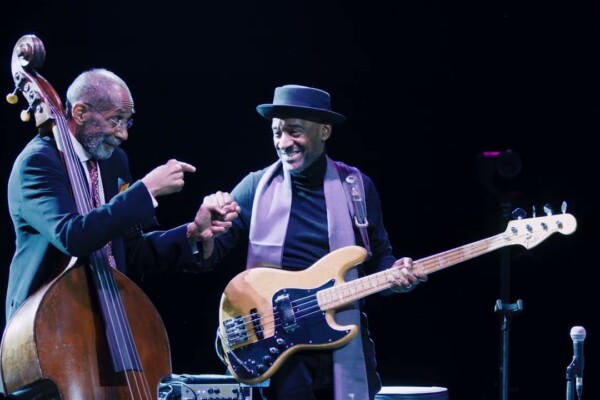Review: Marcus Miller’s “A Night in Monte Carlo”
 Having and developing an individual voice is so important in music. Michael Jackson, Cannonball Adderley, Miles Davis, Wayne Shorter: we recognize all of them within a few notes. And Marcus Miller is someone with an instantly recognizable style on bass; he has found his own voice in music in his composition, arrangement and production. His music sounds natural and flows freely. Everything grooves in a soulful, accessible way and the overwhelming impression is that of a musician fabulously enjoying music making.
Having and developing an individual voice is so important in music. Michael Jackson, Cannonball Adderley, Miles Davis, Wayne Shorter: we recognize all of them within a few notes. And Marcus Miller is someone with an instantly recognizable style on bass; he has found his own voice in music in his composition, arrangement and production. His music sounds natural and flows freely. Everything grooves in a soulful, accessible way and the overwhelming impression is that of a musician fabulously enjoying music making.
A Night in Monte Carlo is a recording of a special live concert. It was commissioned for November 29, 2008 in Monaco and featured Miller with his band, his arrangements for the Monte Carlo symphony orchestra and special guests, trumpeter Roy Hargrove and singer Raul Midón.
The concert opens in spectacular manner with the Middle Eastern-tinged “Blast” from the bassist’s 2008 release, Marcus. Miller lays down some serious slap and the orchestra lines add depth and atmosphere before Alex Han comes in with some wailing alto saxophone. The rhythmic cushion laid down by Miller mixed with the ever-wonderful Poogie Bell on drums grooves menacingly. DJ Logic adds a layer of percussion with turntables and Miller takes the tune out with some joyous slapped bass.
“So What” has Gil Evans’ exquisite (and rarely played) introduction scored by Miller for orchestra. Miller plays the famous bass theme with the orchestra answering over simple, funky drumming. Federico Gonzalez Peña on piano and Miller (at length) on fretted Jazz get to stretch out over the relaxed funky jazz groove and tasteful orchestrations.
“State of Mind” opens with Midón’s percussive and effervescent guitar and soulful vocals, and Miller joins with some splendid fretless grooving. Miller’s fretless is deep-toned and lush and played with nimble agility. The tune works particularly well as a duo performance, making an effective contrast with the tracks featuring full orchestration.
Gershwin’s famous “I loves you Porgy” is a wonderful feature for Miller’s beautiful fretless melody playing. This is a great performance, and listening to a player as great as Miller playing the melody over a full orchestration, one can’t help but make you notice how far this instrument has come. Could anyone have imagined the electric bass playing a role like this when it first arrived on the scene? It’s not just about the bass though, Miller’s musicality shines through. The bass is just the vehicle, Marcus Miller plays Marcus Miller.
“Amandla” written, of course, for Miles Davis, features the gorgeous, soaring trumpet of Roy Hargrove. This track benefits from the colors available with a whole orchestra and it features a range of moods… soaring at times, especially under Han’s saxophone solo. Miller is bluesy with restrained brilliant energy, like a coiled spring – lots of palm mute and groove-filled tension and chromatic runs. Bell’s playing focuses around his dramatic snare work and after Hargrove solos at length, trumpet and saxophone spar furiously. Miller’s own solo is dark and brooding as he once again features the fretless, making some expressive use of sliding harmonics.
The standard “I’m Glad There Is You” again features Hargrove, this time in ballad mode on romantic flugelhorn over sweet strings, subtle piano, tasteful retrained bass playing, and brushes from Bell. Hargrove sounds particularly at home on this tune, sounding like a lover whispering sweet things to the object of his adoration.
This is record is not one without surprises. Perhaps some might not expect Miller to play fretless in a similar role to Miles Davis’ trumpet on “Porgy and Bess”, certainly few would have expected a tender, straight-ahead jazz ballad. Even fewer would have likely predicted the next track: a lovely melodic statement from Giacomo Puccini’s “O Mio Babbino Caro (Oh, my dear papa)”, a highlight from his 1918 one-act opera Gianni Schicchi.
Miller’s fretless is in the operatic tenor’s role, paradoxically the part is normally performed by a soprano. The short statement leads directly into a funky version of “Mas Que Nada”. The band clearly have a blast on Jorge Ben’s famous tune. Miller is back on fretted synching beautifully with Bell’s drumming. Midón sings and takes a scat/guitar unison solo after Han’s lively and playful alto solo. Hargrove solos over the joyous samba bounce alternating somewhat strangely Midón’s trumpet impression scat. Seriously infectious head-bobbing stuff!
The album ends with a pair of ballads. First up is “Your Amazing Grace”, introduced by Miller on bass clarinet. He plays quite beautifully on the instrument before Han takes his own expressive solo over Miller’s lyrical fretless work. A pity only that there wasn’t a Chaka Khan or Lalah Hathaway available to sing the vocal, although Midón does a decent enough job.
Then there is “Strange Fruit”, forever associated with Billie Holiday. Miller recorded this in L.A. on his return from tour “as a reflection of the impression this experience has left on me.” Again, this is a tune that features his bass clarinet. His evocative lines are backed by Herbie Hancock on piano and a haunting orchestration.
A Night in Monte Carlo is a lovely record. Miller has developed his own style and his own music – accessible, sophisticated and engaging- this will appeal to a wide audience. It’s not just for bassists, although we will undoubtedly enjoy it.
Personnel: Marcus Miller: bass, bass clarinet; Roy Hargrove: trumpet, flugelhorn; Raul Midón: vocals, guitar; Alex Han: alto saxophone; DJ Logic: turntables; Federico Gonzalez Peña: piano, keyboards, percussion; Poogie Bell: drums; Herbie Hancock: piano (Strange Fruit); Orchestre Philharmonic De Monte-Carlo.




Hey guys if you open up your ears,you’ll notice that “State of Mind” is definitely not a fretless and it’s not a duo, there’s percussion too! Or did I buy a completely different version of the CD?
1 – my ears are open
2 – it still sounds tonally like a fretless to me, though I’m open to persuasion on that
3 – it’s a duo! There is some percussive banging from Midon on the body of his guitar and at one point during the scat solo it sounds like either Midon or a percussionist is tapping along for a few bars but that doesn’t change the nature of essentially a duo performance.